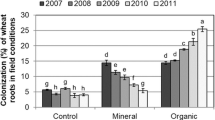Abstract
An experiment was carried out to study the effect of spacing of tree species on native AM fungi and microbial biomass C in the soil in an alley cropping system. The treatments comprised of 3 spacings (4, 8 and 12 m) as main plots, two perennial leguminous plant species (Gliricidia—Gliricidia sepium and Leucaena—Leucaena leucocephala) as subplots and three field crops (finger millet—Eleusine coracana, peanut—Arachis hypogea and pigeonpea—Cajanus cajan) as sub–sub plot treatments laid out in a split–split plot design with four replications. Growing finger millet, pigeonpea and peanut in between Leucaena supported mycorrhizal parameters like spore numbers and infective propagules of AM fungi in the rhizospheric soil compared to those grown in between Gliricidia. The microbial biomass C in soil was more in all the three alleyed crops grown in between Gliricidia. Spacing of 12 m between trees supported all the microbial parameters studied (except mycorrhizal spore numbers) and also the yield of finger millet, pigeonpea and peanut. Growing finger millet as an alley crop in between Gliricidia spaced 12 m apart considerably improved the yield of finger millet.
Similar content being viewed by others
References
Bagyaraj DJ (1984) Biological interactions with VAM fungi. In: Powell CL, Bagyaraj DJ (eds) VA mycorrhiza. CRC Press, Boca Raton, Florida, pp 131–153
Bagyaraj DJ (2014a) Mycorrhizal fungi. Proc Indian Natn Sci Acad 80:415–428
Bagyaraj DJ (2014b) Interaction between arbuscular mycorrhizal fungi and the soil organisms and their role in sustainable agriculture. In: Singh DP, Singh HB (eds) Trends in soil microbial ecology. Studium Press LLC, USA, pp 257–280
Carter MR (1991) Ninhydrin– reactive N released by the fumigation extraction method as a measure of microbial biomass under field conditions. Soil Biol Biochem 23:139–143
Diagne O, Ingleby K, Deans JD, Lindley DK, Diaité I, Neyra M (2001) Mycorrhizal inoculum potential of soils from alley cropping plots in Sénégal. For Ecol Manage 146:35–43
Gerdemann JW, Nicolson TH (1963) Spores of mycorrhizal Endogone species extracted from the soil by wet sieving and decanting. Trans Br Mycol Soc 46:235–244
Giovannetti M, Mosse B (1980) An evaluation of techniques to measure vesicular arbuscular infection in roots. New Phytol 84:489–500
Harley JL, Smith SE (1983) Mycorrhizal symbiosis. Academic Press, New York
Henriksen I, Michelsen A, Schlönvoigt A (2004) Tree species selection and soil tillage in alley cropping systems with Phaseolus vulgaris L. in a humid premontane climate: biomass production, nutrient cycling and crop responses. Plant Soil 240:145–159
Jenkinson DS, Ladd JN (1981) Microbial biomass in soil measurement and turnover. In: Paul A, Ladd JN (eds) Soil biochemistry, vol 5., Marcel DeckerNew York, Basel, pp 415–471
Kasirayi M (2014) Agroforestry trees as source of n for sustainable alley cropped maize (Zea mays L.) yield on depleted loamy soils. Greener J Soil Sci Plant Nutr 1:16–22
Kumar P, Halepyati AS, Pujari BT, Desai BK (2007) Effect of intergrated nutrient management on productivity, nutrient uptake and economics of maize (Zea mays L.) under rain fed conditions. Kar J Agric Sci 20:462–465
Lee KH, Jose S (2003) Soil respiration and microbial biomass in a pecan - cotton alley cropping system in Southern USA. Agroforest Syst 58:75–82
Little TM, Hills FJ (1978) Agricultural experimentation: design and analysis. John Wiley and Sons, New York
Lundquist EJ, Jackson LE, Scow KM, Hsua C (1999) Changes in microbial biomass and community composition, and soil carbon and nitrogen pools after incorporation of rye into three California agricultural soils. Soil Biol Biochem 31:221–236
Mazzarino MJ, Szott L, Jime´nez M (1993) Dynamics of soil total C and N, microbial biomass, and water soluble C in tropical agroecosystems. Soil Biol Biochem 25:205–214
Muleta D, Assefa F, Nemomissa S, Granhall U (2008) Distribution of arbuscular mycorrhizal fungi spores in soils of smallholder agroforestry and monocultural coffee systems in southwestern Ethiopia. Biol Fertil Soils 44:653–659
Nobre CP, de Lima Ferraz Júnior AS, Goto BT, Berbara RLL, Nogueira MDC (2010) Arbuscular mycorrhizal fungi in an alley cropping system in the state of Maranhão, Brazil. Acta Amazonica 40:641–646
Okon IE, Solomon MG, Osonubi O (2010) The effects of arbuscular mycorrhizal fungal inoculation and mulch of contrasting chemicalcompositioin on the yield of cassava under humid tropical conditions. Sci World J 10:505–511
Osonubi O, Ekanayake IJ (2003) Contributions of an alley cropping system and arbuscular mycorrhizal fungi to maize productivity under cassava intercrop in the derived savannah zone. J Agric Sci 140:311–316. doi:10.1017/S0021859603002946
Oyetunji OJ, Osonubi O (2007) Assessment of influence of alley cropping system and arbuscular mycorrhizal (AM) fungi on cassava productivity in derived savanna zone of Nigeria. World J Agri Sci 3:489–495
Palada MC, Kang BT, Claassen SL (2005) Effect of alley cropping with Leucaena leucocephala and fertilizer application on yield of vegetable crops. Agroforest Syst 19:139–147
Phillips JM, Hayman DS (1970) Improved procedures for clearing and staining parasites and vesicular arbuscular mycorrhizal fungi for rapid assessment of infection. Trans Br Mycol Soc 55:158–161
Seiter S, Ingham ER, William RD (1999) Dynamics of soil fungal and bacterial biomass in a temperate climate alley cropping system. Appl Soil Ecol 12:139–147
Sieverding E (1991) Vesicular arbuscular mycorrhiza management in tropical agro-ecosystems. GTZ, Eschborn
Snedecor GW, Cochran WG (1968) Statistical methods, 6th edn. The Iowa State University Press, Ames
Sundar Raj N, Nagaraj S, Venkataramu MN, Jagannath MK (1972) Design and analysis of field experiments. University of Agricultural sciences, Bangalore, pp 106–110
Author information
Authors and Affiliations
Corresponding author
Rights and permissions
About this article
Cite this article
Balakrishna, A.N., Lakshmipathy, R., Bagyaraj, D.J. et al. Influence of alley copping system on AM fungi, microbial biomass C and yield of finger millet, peanut and pigeon pea. Agroforest Syst 91, 487–493 (2017). https://doi.org/10.1007/s10457-016-9949-4
Received:
Accepted:
Published:
Issue Date:
DOI: https://doi.org/10.1007/s10457-016-9949-4




